In this article you will learn how to write an Effective Abstract for a Research Paper.
An abstract is a brief summary of a research paper. Its purpose is to provide readers with a clear overview of what the paper is about and why it is important.
To write an effective abstract, authors should follow these four steps:
1) identify the main purpose of the paper
2) provide a brief overview of the paper’s main points
3) state the paper’s conclusions
4) offer some implications for further research.
There are a few things to keep in mind when writing an abstract for a research paper.
- First, the purpose of an abstract is to give the reader an overview of the paper.
- Second, the abstract should be easily readable.
- Third, the abstract should be concise and to the point.
What is an Abstract?
A dissertation or research paper abstract is a concise overview of a lengthy work. An abstract is a brief summary of a research article, thesis, or dissertation. Its purpose is to inform readers of the paper’s contents without them having to read the entire paper.
When writing a thesis, dissertation, research paper, or submitting an article to a scholarly journal, you must always include an abstract.
Read more to learn how to write Abstract for Research Paper and download PDF for free.
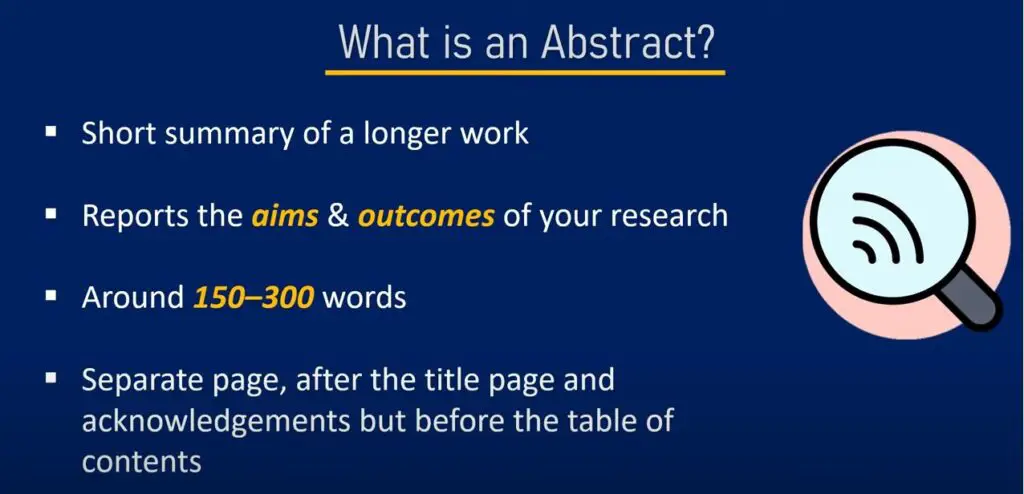
Points to remember while writing your abstract
- In order for readers to understand exactly what the paper is about, the abstract should clearly describe the objectives and findings of your research.
- In a dissertation or thesis, an abstract typically ranges from 100 to 300 words, but journals and universities frequently have tight word limits, so be sure to check them.
- The table of contents is placed before the abstract, which is on a separate page following the title page and acknowledgments.
- An snippet from your essay or dissertation should not be included in an abstract; it should be a fully distinct work.
An abstract should be totally comprehensible even if the reader hasn’t read your entire paper or any connected sources.
The simplest strategy is to imitate the bigger work’s structure while producing an abstract.
Consider it a shorter version of your research paper or dissertation.
How to write an abstract for a research paper?
An abstract is a brief summary of a research paper. It should be done last after you have completed your paper. This will give you a good overview of what to include.
Here are some tips on how to write an effective abstract:
1. Start by introducing the topic of your paper and its main argument or hypothesis.
2. Give a brief overview of the methods you used in your research.
3. Summarize the key findings of your paper in one or two sentences.
4. End with a brief conclusion that restates your main argument and highlights the implications of your work for future research.
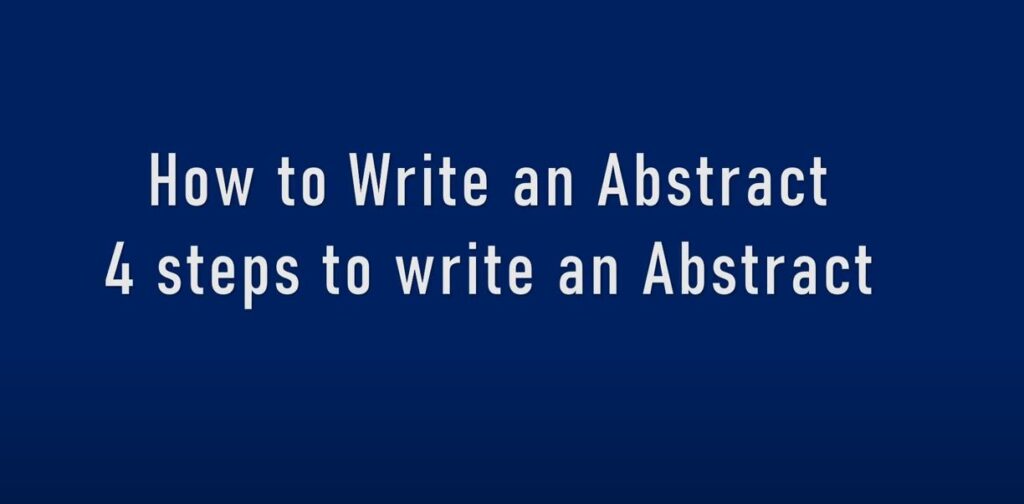
4 key steps
When you are writing an abstract for a research paper, there are certain things that you need to include in order to make sure that your abstract accurately reflects what is in your paper.
The first thing that you need to do is to identify the purpose of your paper.
What are you trying to accomplish with your research?
In most cases the abstract should contain four key elements.
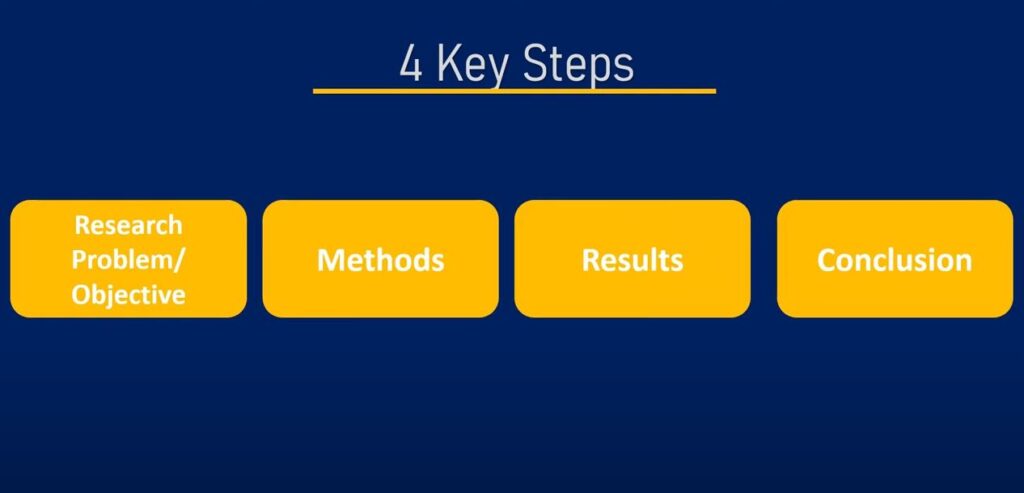
Once you know the purpose, you can then start to think about what you need to include in your abstract.
1) Research problem and objectives
2) Methods
3) Key results or arguments
4) Conclusion

1- Add research problems and objectives
Step one add research problem and objective.
Research problems and objectives are one of the most important things that you need to include in your abstract. They give the reader an overview of what you hope to achieve with your research. Also, they provide more specific information about the reason to conduct a research.
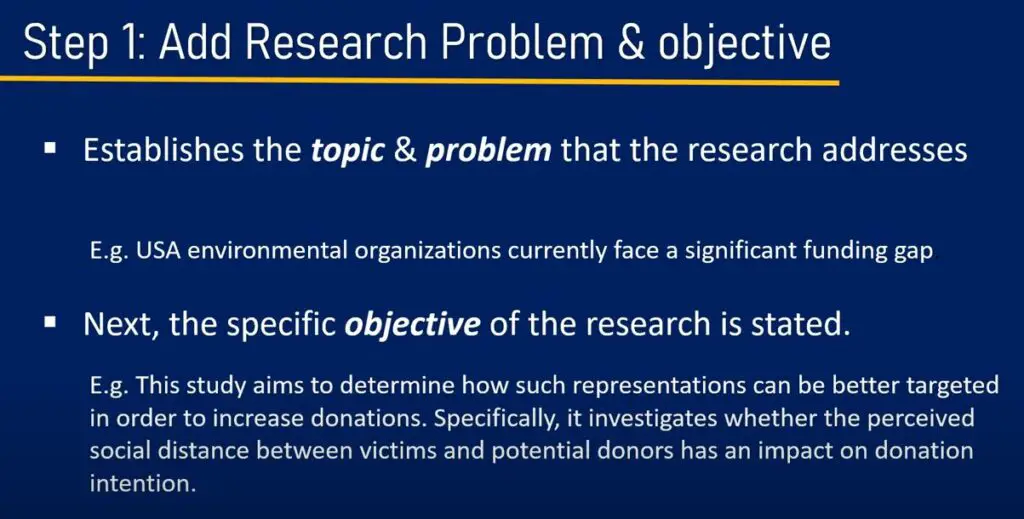
Without these two key elements, it would be difficult for readers to understand what your paper is about and what they can expect from reading it.
The research’s topic and primary issue are established in the first sentence.
For instance, there is currently a substantial financing vacuum for US environmental organizations.
Research procedures used to produce the findings should be described. A short description should be in one or two sentences. A description of the research methodology should provide insight into procedures and approach.
For instance, the goal of this study is to ascertain how such representations might be more effectively targeted to boost donations.
In particular, it looks into whether the perceived social distance between victims and potential donors affects the intention to donate.
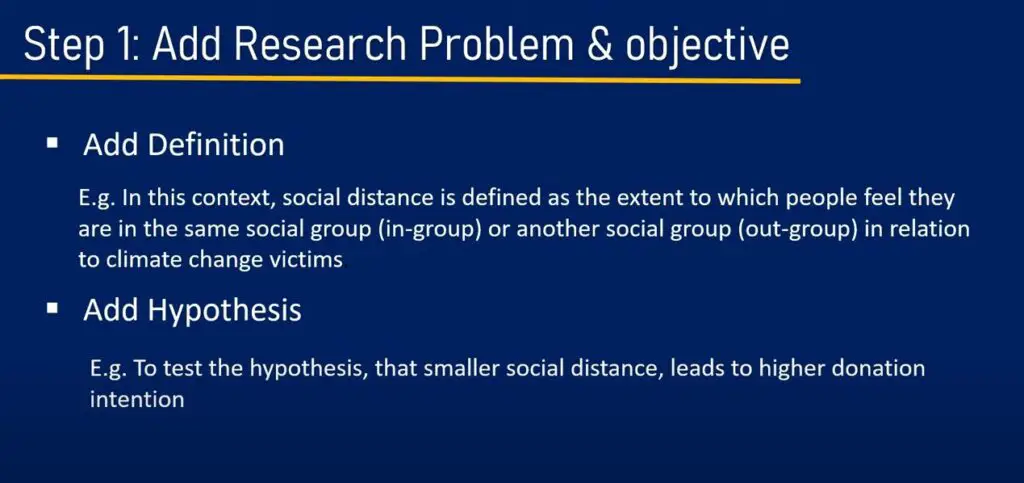
Add definition
Give a brief definition of any specialized terminology in your abstract that the ordinary academic reader might not be familiar with or that have more than one meaning.
For instance, in this context, social distance is defined as the degree to which individuals feel they belong to the same social group as climate change victims, or to a different social group, respectively.
Hypothesis
The study’s hypothesis is made very clear.
For instance, to examine the theory that closer social ties result in greater contribution intent.
2- Add method
The next step is a brief description of the methods used.
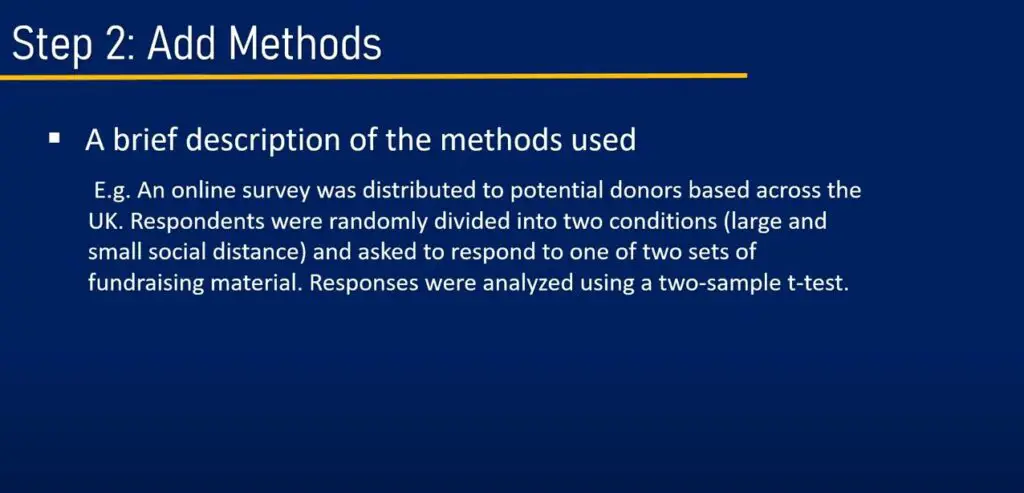
Example
For example, A survey was made available online to prospective donors from throughout the UK. Responses were examined using a two-sample t-test after respondents were randomly assigned to one of two conditions—large social distance or little social distance—and asked to respond to one of two sets of fundraising materials.
3- Add results
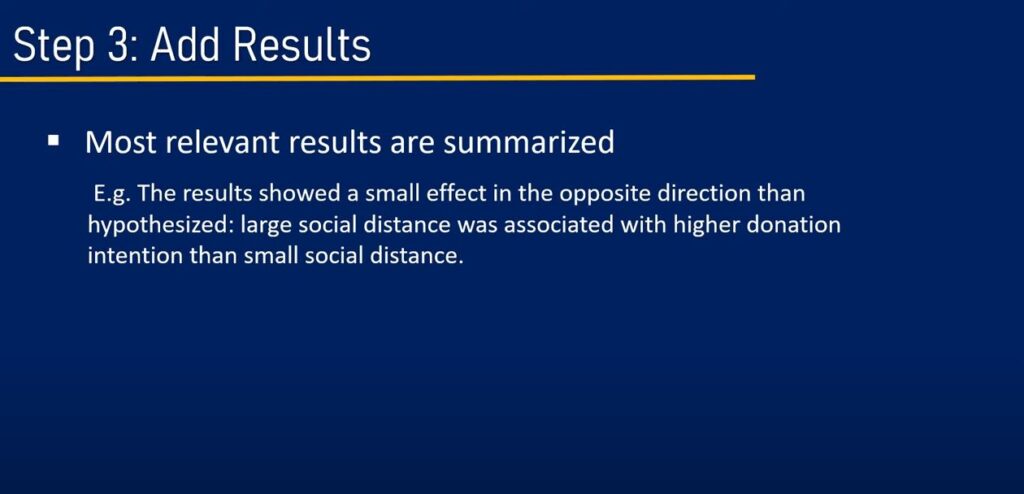
1. Summarize the results of your study as represented in your paper.
2. Highlight key findings that will be helpful in understanding your results and outcomes.
The most crucial results are highlighted.
Example
In contrast to what was predicted, the data, for instance, indicated that great social distance was related with a larger intention to donate than short social distance.
4-Add conclusion
The conclusion of a research paper needs to restate the main argument and supporting points. A strong conclusion will provide a sense of closure to the essay while again placing your concepts in a somewhat wider context. It will also, in some instances, add a stimulus to further thought.
There are a few things that need to be included in a good conclusion:
1) Clearly state the conclusion of research highlighting the answer to your research question.
2) A re-statement of your main argument or analysis;
3)Research abstract should represent the central point which your research has proven or disapproved.
4) A summary of your key points;
5) An assessment of how well you have argued your case;
6) Some suggestions for further research (if appropriate).
The primary conclusions of the study are then presented, demonstrating how the findings address its purpose. This research included recommendations since it concentrated on a real-world issue.
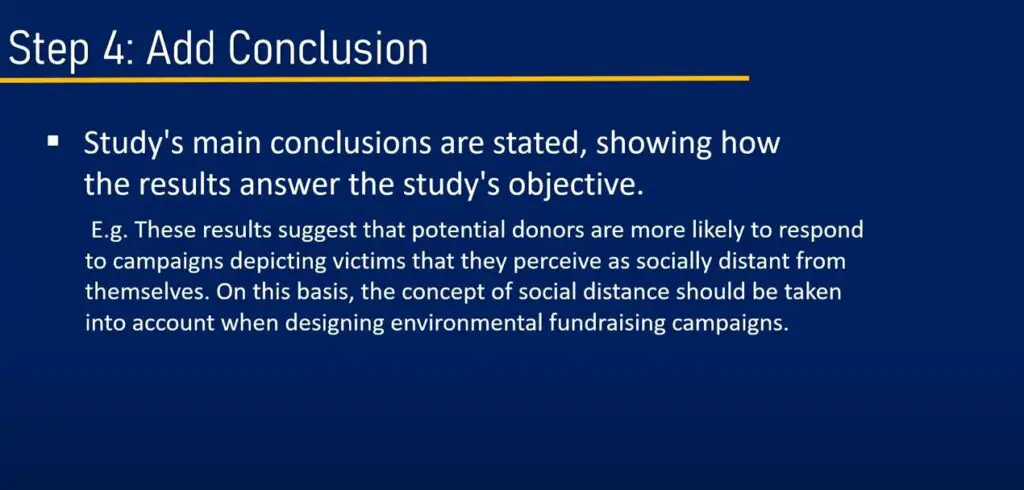
Example:
These findings, for instance, imply that potential contributors are more inclined to support campaigns that feature victims who they believe to be socially removed from themselves. As a result, the concept of social distance should be considered while developing environmental fundraising campaigns.
Keywords
You might need to include a list of keywords at the conclusion of the abstract if your work will be published. To make it easier for potential readers to find your work during their own literature searches, these keywords should refer to the key points of your research.
Be aware that some manuals on writing for publications, such APA Style, have particular formatting guidelines for these keywords.
Example of Abstract

- Problem: Write down your problem first.
- Objective: Begin by stating your research’s objective in unambiguous terms.
What theoretical or practical issue does the study address, and what research topic did you set out to address?
After determining the problem, clarify your research’s objective. Using verbs like “explore,” “test,” “analyse,” or “assess,” describe precisely what you set out to do. This section of the abstract may be written in the present tense or the past simple, but it must never relate to the future because the research has already been done.
- Definition: If your abstract contains technical jargon, provide a definition. Give a brief explanation.
- Hypothesis: Add your hypothesis. This section clearly states the study’s hypothesis.
- Method: Describe the research techniques you used to address your question.
This section should provide a brief, one- or two-sentence summary of what you accomplished. Since it relates to acts that have already been performed, it is typically written in the past tense.
- Results: The next section of the abstract should summarize the results; this section can be written in either the present or past simple tense.
- Conclusion: Lastly, summarize the conclusions of your research.
What is your answer to the problem or question?
Conclusions are typically stated in the present simple tense and should leave the reader with a clear comprehension of the main point that your research has established or advocated.
How to format an Abstract for Research Paper
An abstract is a summary of your research paper. It should be about one paragraph long and should include the following:
1. The research question you are investigating.
2. The methods you used to investigate this question.
3. Your findings.
4. A brief discussion of your findings in relation to the literature on this topic.
Header: To format your abstract, center the title “Abstract” at the top of the page and use standard margins.
Body: Begin the body of your abstract on the next line after the title with a normal indent (one half-inch). The body of your abstract should be double-spaced throughout. For the body of your abstract, use a normal letter size font (12-point Times New Roman or Arial) in standard margins.
Do not put any additional information on this page; it should be left blank.
When to write an Abstract for Research Paper?
You should write an abstract for your research paper once you have finished writing the paper. This will give you a chance to summarize what you have done and why it is important. Â It is a good idea to write the abstract first because it can be difficult to do this when you are already finished with your paper.
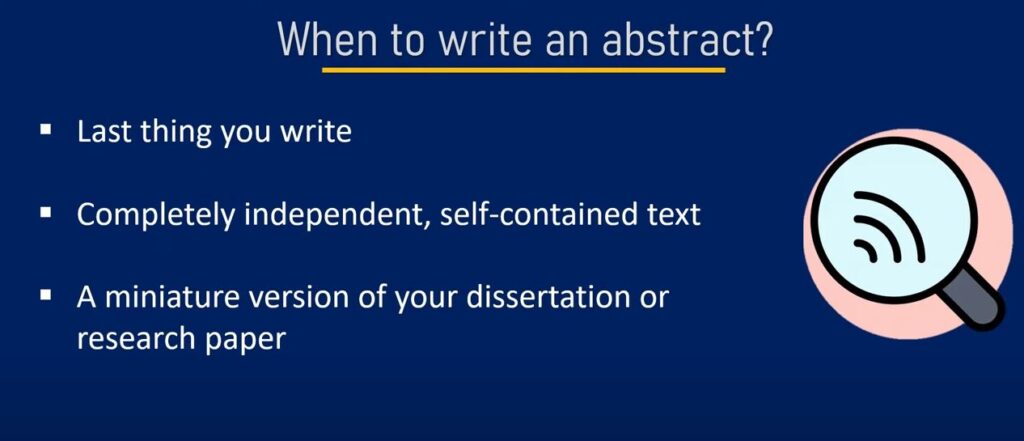
An abstract is nearly always required when:
- Finishing a dissertation or thesis
- Submitting a research paper to a scholarly publication
- A book proposal is written.
- Requesting research grants
Best Practices
Since your abstract is a recap of the work you’ve previously done, it’s easiest to write it last. Your abstract ought to:
- Be a single text rather than a passage from your dissertation/research paper.
- Be completely comprehensible on its own.
- Describe how your larger work is structured.
Types of Abstracts
Abstracts are summaries written to give readers a glimpse of what a paper is about. They are written after the introduction and before the main body of the paper.
There are four types of abstracts: informational, descriptive, indicative, and critical.
1) Descriptive Abstract
2) Informative Abstract
3) Persuasive Abstract
4) Critical Abstract
Descriptive Abstracts
- Descriptive abstracts simply describe the research that has been done, without offering any analysis or interpretation.
- provide a brief overview of the paper, including its purpose, scope, and conclusions.
- They are usually fairly short – around 100 words.
Example
Here is an example of a descriptive abstract:
“This study investigated the effects of music on task performance. Sixty-four college students participated in the study, which was conducted over four weeks. The participants were randomly assigned to one of four conditions: (1) no music; (2) music they liked; (3) music they disliked; or (4) classical music. The results showed that participants in all three music conditions outperformed those in the no-music condition on measures of task performance and concentration. These findings suggest that music can be beneficial for task performance, regardless of whether it is liked or disliked by the listener.”
Informative Abstracts
- Simply provide information about what is in the paper without any sort of evaluation or opinion.
- It provides a summary of the findings as well as the methodology used in the research.
- Usually include the purpose, methods, scope, and results of the paper.
- These abstracts are usually slightly longer – around 200 words.
Example
An example of an informational abstract would be:
“The purpose of this study was to examine the effects of sleep deprivation on college students’ grades. The sample consisted of 100 college students who were randomly assigned to either a sleep-deprived or control group. The findings showed that students in the sleep-deprived group had lower grades than those in the control group.”
Persuasive Abstracts
- Persuasive abstracts take an even more in-depth look at the research.
- Provides not only a summary of findings but also an argument for why the research is important and how it contributes to the wider conversation on the topic.
- Persuasive abstracts can be up to 500 words in length.
Example
“This study examined the effects of a new reading program on elementary school students’ reading achievement. The results showed that students who participated in the program made significant gains in reading proficiency. This finding suggests that the program is an effective tool for improving reading achievement in elementary school students”.
Critical Abstracts
- Provides a concise review of a text, article, or book.
- Gives the reader an overview of the author’s argument and main points.
- Includes a brief summary of the work, followed by a critical evaluation.
- The evaluation portion of the abstract should include your own opinion of the work, as well as its strengths and weaknesses.
Example
Here is an example of a critical abstract:
In his article “The Use and Abuse of Literacy in Medieval England,” Richard Sharpe examines how literacy was used both as a tool for social control and as a way to assert power within society. Sharpe argues that literacy was used primarily as a means of control by the ruling class, and that this resulted in a largely illiterate population. He also points out that literacy was often seen as dangerous and threatening by those in power, which led to its abuse.
Take Away
In conclusion, following these simple tips for writing an effective abstract for a research paper will help to engage your reader and communicate the main points of your work. A well-written abstract will also help to sell your paper to conference organizers and editors, so it is worth taking the time to craft a good one.
In conclusion, remember that the purpose of an abstract is to give readers a quick overview of the paper. It should be concise and free of any superfluous information. Be sure to proofread it for any errors before submitting your research paper! This article has given you the overview of how to write an Effective Abstract for a Research Paper.
Other articles
Please read through some of our other articles with examples and explanations if you’d like to learn more about research methodology.
Statistics
Methodology
- Research Methods
- Quantitative Research
- Qualitative Research
- Case Study Research
- Survey Research
- Conclusive Research
- Descriptive Research
- Cross-Sectional Research
- Theoretical Framework
- Conceptual Framework
- Triangulation
- Grounded Theory
- Quasi-Experimental Design
- Mixed Method
- Correlational Research
- Randomized Controlled Trial
- Stratified Sampling
- Ethnography
- Ghost Authorship
- Secondary Data Collection
- Primary Data Collection
- Ex-Post-Facto
Research
- Table of Contents
- Dissertation Topic
- Synopsis
- Thesis Statement
- Research Proposal
- Research Questions
- Research Problem
- Research Gap
- Types of Research Gaps
- Variables
- Operationalization of Variables
- Literature Review
- Research Hypothesis
- Questionnaire
- Abstract
- Validity
- Reliability
- Measurement of Scale
- Sampling Techniques
- Acknowledgements



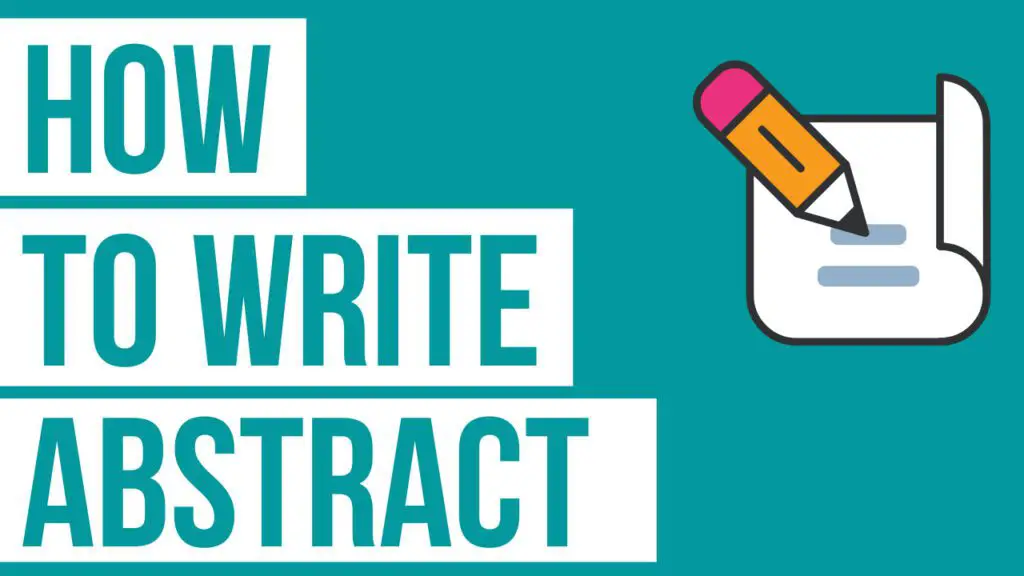
1 Comment
Thank you for the sensible critique. Me & my neighbor were just preparing to do a little research about this. We got a grab a book from our area library but I think I learned more clear from this post. I’m very glad to see such wonderful info being shared freely out there.